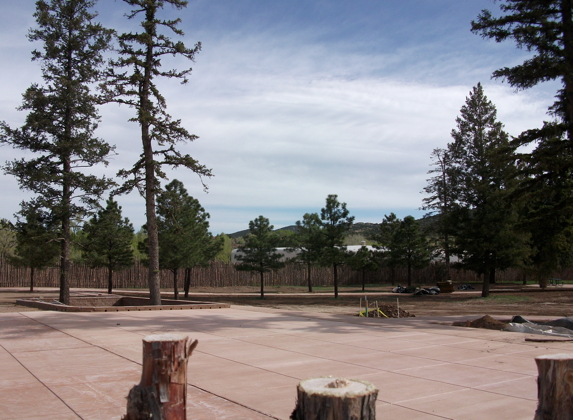
The Power Plant Park on Canyon Road
Friday morning I met my friend Mac Watson at the new park on Canyon Road where, in his role as a historic conservationist, he is rehabilitating the old hydroelectric building. He introduced me to Victor Johnson, the landscape architect for the project, and we embarked on a tour of the grounds. The concrete parking slab doesn’t appear nearly so vast when you’re standing right on top of it, and Mr. Johnson was quick to note that there had been no meadow on this corner of the site, just a dark, oppressive thicket of Siberian elms, Santa Fe’s most reviled weed tree. He also noted that the grass in the rest of the park, wiped out by the construction, will be replaced not by hydroseeding, as originally planned, but by hand.
I hadn’t meant to direct my criticism at the design of the park — given the constraints he was handed, Mr. Johnson has done a graceful, aesthetically pleasing job — but with how the demands of bureaucracy turned what could have been a simpler, low-key endeavor into such an intensive development.
The reason for the high concrete-to-grass ratio is that the city decided each picnic table, no matter how distant from the parking area, had to be handicap accessible. (Concrete rather than packed gravel was used, Mr. Johnson said, to reduce the cost and difficulty of long-term maintenance.) Should four separate parties of picnickers in wheelchairs or scooters arrive simultaneously they can all be accommodated, and with pathways so wide as to allow for two-way traffic. The Americans With Disabilities Act is an important piece of legislation, but here it has been carried to an extreme — at the expense of the natural habitat.
The day before the tour, Chip Lilienthal of the City Facilities Division assured me in an email that “Phase 1” of construction will finally end this month. Alas, there is to be a Phase 2: building the restrooms and completing interior work on the old power station, which will serve as the focus of a Water History Museum. That part is definitely going to be worth the wait. As Mac Watson reminded me, the harnessing of the Santa Fe River for electrical power a century ago was the first step in a sequence that led to a communal resource becoming commoditized. From then on water was a product to be impounded, sold, piped to profitable new locations. Development began dictating supply, instead of vice versa, and the town kept growing larger and drier. The new Power Plant park will be a place to step off the treadmill for a moment and consider the consequences.
George Johnson
The Santa Fe Review
